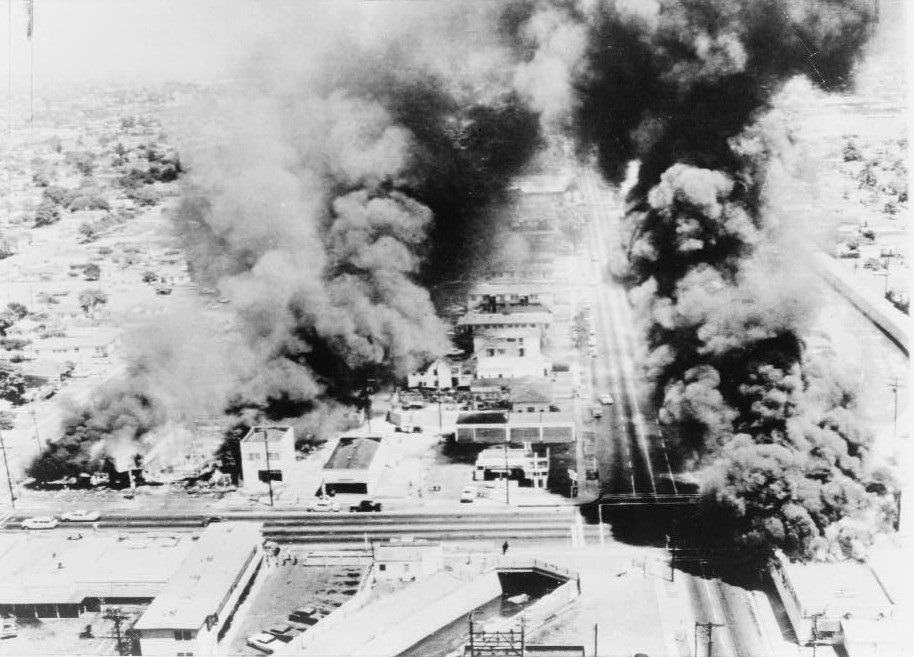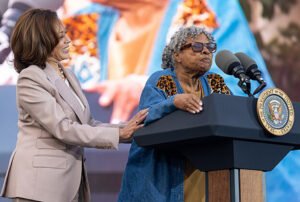
August 11, 2015; New York Times
In a week of direct action by people associated with the #BlackLivesMatter targeting Democratic presidential candidates Bernie Sanders and, for a moment, Hillary Clinton, it might not have struck many of the young activists that a half century ago, an eruption of black anger against conditions in the Watts neighborhood captured the attention of the nation. Looking backward and looking at today, we can see parallels that might be important for the nation—and for the nonprofit sector.
Shouldn’t be surprised: As the Watts uprising took shape, white leaders such as California Governor Pat Brown acknowledged that they had been completely surprised by the depth of black anger. Like many liberals, they actually thought that Los Angeles wasn’t the Deep South, and that black Angelenos were well treated and should have been happy (or at least happier) with their conditions. In fact, just before the uprising, President Johnson had signed the Voting Rights Act and the elements of the War on Poverty were unrolling. Like today, white liberals—and progressives for that matter—made assumptions about people of color and substantially misjudged just how angry and, in light of incidents of extreme police violence, just how fearful black Americans are about conditions in their communities. It isn’t guilty white liberalism to suggest that even whites who claim to care about and support the advancement of the black community may be deaf in tone and substance to what is happening in communities of color.
More organized activity than it seems: To critics, Watts looked like a violent spasm of protest that appeared out of nowhere. In reality, nonprofit community groups in the black community of Los Angeles had long been organizing around issues of school segregation, housing segregation, overcrowded black schools, inadequate numbers of black teachers, police brutality, and political gerrymandering, though political leaders had been unresponsive. While there is little evidence that there was much organized activity in Ferguson before Michael Brown’s death, there is no question that groups had been raising issues about the police mistreatment of young black men and women in Baltimore, Cleveland, and New York before the tragic deaths of Freddie Gray, Tamir Rice, and Eric Garner before citizens took to the streets in protest. As in Los Angeles a half-century ago, the unwillingness of political leaders to make sufficient changes in policies toward people of color doesn’t mean that community-based organizing hadn’t been occurring and raising the issues that eventually turned into street protests and direct action.
Direct action works: While there is some suspicion that the #BlackLivesMatter activists gave Hillary Clinton something of a soft pass compared to their takeovers of Bernie Sanders events, treating her with more respect than Sanders when Sanders’s civil rights record is no less than Clinton’s, they did finally show up at a Clinton event (though having informed The New Republic of their plans so that the Secret Service could shuffle them into an overflow room, avoiding a public confrontation with the candidate) and succeeded in getting 15 minutes of behind-the-scenes time with Clinton herself. That’s quite an accomplishment. Some progressives might have been upset that Sanders had become a BLM target, but BLM actions in Phoenix and Seattle prompted the candidate to issue a detailed and powerful racial justice platform. That’s a far cry from the “I (heart) nonprofits” strategy that some nonprofit leaders adopted in recent national elections. If the objective is to get a statement that is more than soft soap, the strategy has to be tougher and more direct.
People know more today due to social media: In 1965, generating the research to make a point was tough. Those who don’t remember pre-computer days should use their imaginations. Today, with Twitter, Facebook, and Reddit, failure to do your research can be quickly exposed. For example, Sanders has a strong and admirable record as a civil rights activist in his days before coming to Congress, apparently little known to some of his Black Lives Matter critics who demanded that he make up for his past. It doesn’t appear that some of critics of Hillary Clinton have taken much note of it, but Lee Fang at The Intercept wrote recently about lobbyists for two major private prison operators serving as “top fundraisers” for Clinton. They are the beneficiaries of the “mass incarceration” policies that Clinton has recently criticized. Much of today’s politics is instant perception, but the information is there for activists who want it to challenge the candidates—and themselves—about what is being said.
Sign up for our free newsletters
Subscribe to NPQ's newsletters to have our top stories delivered directly to your inbox.
By signing up, you agree to our privacy policy and terms of use, and to receive messages from NPQ and our partners.
Underlying meaning: In the wake of Watts, Dr. Martin Luther King, Jr., in his usual, amazing way of getting to the heart of the issue, described what he perceived from the uprising:
I think that what has gone on here in Los Angeles these past days is of national significance. What we are witnessing here is the beginning of a stirring of those people in our society who have been by passed by the progress of the past decade. For this reason, I would minimize the racial significance and point to the fact that these were the rumblings of discontent from the “have nots” within the midst of an affluent society. After visiting the area of the recent riots and talking with hundreds of people of all walks of life, it is my opinion that these riots grew out of the depths of despair which afflict a people who see no way out of their economic dilemma. There are serious doubts that the white community is in any way concerned or willing to accommodate their needs. There is also a growing disillusionment and resentment toward the Negro middle class and the leadership which it has produced. This ever-widening breach is a serious factor which leads to the feeling that they are alone in their struggle and must resort to any method to gain attention to their plight.
That explains, in a way, the rise of the Black Lives Matter movement and the emergence of leaders such as Deray McKesson and Daunasia Yancey, the latter the Boston chapter BLM leader who was the first questioner in the meeting with Hillary Clinton. And it also explains the sidelining of some more established civil rights leaders, who might be seen as talking a good game for the cameras but not capturing and authentically conveying the discontent that has emerged in the wake of the killings of Brown, Gray, Garner, and others.
New nonprofit capacity and action: Although it started in fits and starts after Watts, the aftermath of the South Central–uprising in 1992 showed a more significant emergence of a nonprofit infrastructure preparing to take on the issues that prior organizations were not prepared or positioned to do. Many of these organizations in both Watts and South Central actually existed prior to the riots, like the Watts Labor Community Action Committee, founded by Ted Watkins only months before the Watts disturbances, and the Community Coalition in South Central having started its activity on land-use issues, specifically trying to limit liquor stores, prior to the riots there. In 2014, this author wrote that in the wake of the South Central civil unrest, “new organizations…emerged ‘from the ashes’ like the Koreatown Immigrant Workers Association, Strategic Concepts in Organizing and Policy Education (SCOPE), Action for Grassroots Empowerment and Neighborhood Development Alternatives (AGENDA), and the Los Angeles Alliance for a New Economy. And pre-existing organizations like the Community Coalition and the Asian Pacific American Legal Center were strengthened in this period as they responded to the civil unrest and built cross-racial alliances.” The Black Lives Matter movement, with chapters around the nation, reflects the inevitable but probably positive dynamic of civil unrest leading to the creation of new entities that replace the organizations that have withered in torpor, unable to anticipate the challenges of today and tomorrow.
What happened in Watts 50 years ago is a kind of “distant mirror,” to use Barbara Tuchman’s metaphor, for what is happening today in Ferguson and elsewhere. The dumbfounded reactions of politicians like Governor Jay Nixon in Missouri or Mayor Stephanie Rawlings-Blake in Baltimore bring to mind the surprise that political leaders voiced when Watts erupted. At the same time, because of the growth of social media, campaigns are possible—like #BlackLivesMatter—that connect otherwise local efforts into a nationwide movement that reaches the likes of Hillary Clinton and Bernie Sanders. For nonprofits and foundations, Watts, South Central, West Florissant Avenue in Ferguson, and Sandtown-Winchester in Baltimore contain lessons that aren’t only applicable to those communities, but spell out directions for the entire nation in addressing racial inequities that remain embedded in schools, the labor market, and, as the deaths of several young black men and women at the hands of police officers demonstrate, the American justice system.—Rick Cohen













